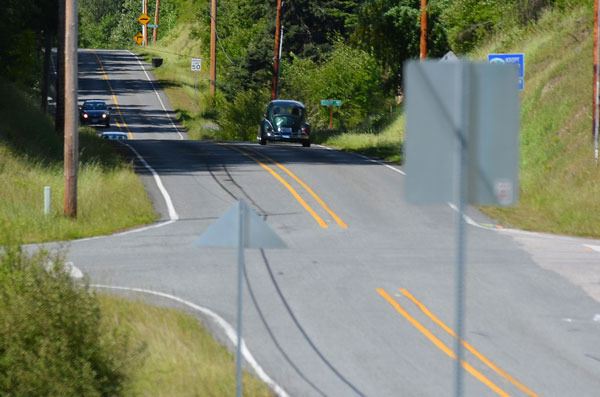A dangerous dip on a rural North Whidbey road is slated for a $1 million fix this summer.
Island County Board of Commissioners last week gave a green light for public works to shave down a car-hiding hill on Zylstra Road just north of the Hastie Lake Road intersection.
Several attention-getting devices designed to warn drivers of the intersection will also be installed on both sides of Hastie Lake Road.
They include flashing stop signs, rumble strips and possibly, a flashing “stop ahead” sign.
Total project cost is estimated at $1.13 million, but this is a Federal Highway Safety Improvement project and $599,452 is covered by grant funds, according to Bill Oakes, director of Public Works.
The remainder, $533,548, will come from public work’s road fund.
As a federal highway safety improvement project, Oakes said, the county was awarded a grant and provided a list of areas where the money might be used. Each was identified as dangerous or having a history of accidents, he said.
The dip and hill on Zylstra — a through street — is so extreme that vehicles are completely hidden to drivers stopped at Hastie Lake Road.
Along with being accident prone, the “physical deficiency”doesn’t meet current code requirements, making it the good choice for the federal funds, Oakes said.
But not everyone is so convinced.
“I think it’s a big waste of money, myself,” said Martin VanRensum, a farmer who has lived near the intersection for more than 70 years.
Despite the dip in the road, accidents at the intersection are not that common and it’s been years since the last one occurred, he said.
VanRensum also questioned the effectiveness of a flashing red stop signs, but, in the end, wasn’t willing to condemn the project entirely.
“It’s probably a good thing. … What do I know?” said VanRensum, giving a shrug and a smile.
Devin Joslin, traffic engineer for Public Works, said VanRensum may be right about accident history at the intersection.
The areas where federal grant money could be used were identified from data collected by a University of Washington study conducted 2002-06.
The study identifies all serious accidents and drew a half-mile circle around them. Any area where more than five circles overlap were singled out as candidates for the federal funding.
Seven accidents took place in the four-year test period, Joslin said, but confirmed only two were at the intersection of Zylstra and Hastie Lake roads.
Both he and Oakes, however, remain confident about the project’s need.
“There is a sight-distance deficiency this project is going to fix,” Oakes said.
“It’s warranted.”
As for the flashing red signs, they get peoples’ attention, he said.
They are so noticeable that have proven track record for reducing accidents and, occasionally, getting on peoples’ nerves.
Oakes confirmed that a flashing stop sign on Camano Island was recently defaced with what is believed to have been a shotgun.
“It looks like somebody shot it twice … but they didn’t kill it,” Oakes told the board last week, earning a round of chuckles from the commissioners.
“It’s still flashing.”
The project has widespread support.
“This is an important improvement and I think it’s a great project,” Commissioner Jill Johnson.
A construction contract still requires approval by the board, but Oakes hopes construction will begin as soon as August.
Work is expected to take about two months.


